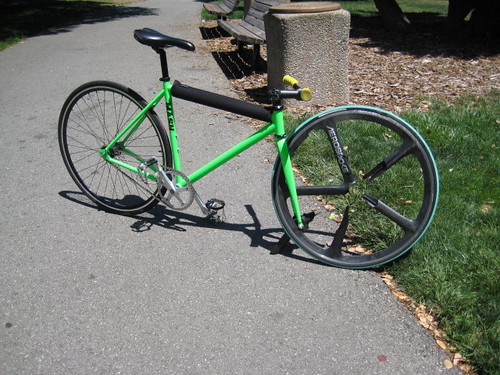^^ What halbritt said. If the manufacturer doesn’t specifically say not to radial lace, I’d say go for it. The fact that formulas are cheap chunky hubs, and not “race light”, would actually tend to increase my confidence.
fuck radially lacing anyway. 3x FTW!
Surly specifically mentions that they will not warrantee a radially laced hub, but I have a radially laced Surly hub that has lasted several years. The Formula will no doubt withstand radial lacing but there is always the small chance of failure. If you like the look of radial, why don’t you lace it 1x? It will look almost radial but less likely to fail.
Other than discontinued Campy high-flange hubs, I’ve not heard of a flange failing on a hub made in the last decade.
[quote=“halbritt”]I radial laced a front formula hub and I didn’t die. I even radial laced the back, kinda. Every other spoke was radial on either side. “Hybrid 32x crow’s foot” or some shit. I still didn’t die.
Note: Most track hubs have equidistant flanges, i.e. no dish. This means that there’s no benefit to DS or NDS radial lacing.
Note 2: A half-radial laced dished wheel is stronger when the radial lacing is DS rather than NDS. Torque will get transferred through the hub to the cross-laced spokes on the NDS just fine. Force vectors, man. Trust me.
Most modern hubs can be radially laced. The benefits are minimal, but they do look cool.[/quote]
You might thrown in a disclaimer that this is one of those enduring debates, and this is how you feel about it. I dunno, maybe the “trust me” says it.
I don’t think it looks cool, buy if you guys like it then go for it.
This.
Radial lacing a dura ace track hub will void the warranty. That said my front wheel is a 36h DA radial laced. I’m a big guy and it hasn’t failed yet, but if it does I guess I’m on my own.
apparently there is a DA front, low flange i think, that is radial safe. its the 20h version and its slotted for bladed spokes. that would be rad, but usually i think radial looks weird.
[quote=“stever”]front wheel fine
rear wheel driveside not so fine[/quote]
Radial rear wheel driveside is perfectly fine, and actually it’s what most of the big wheel makers are doing with high-end race wheels. Check out the 404 or the 808 for 2009. I wouldn’t want it on my commuter wheels, but it’s nothing to scare people over.

In talking with the Zipp people, their belief is that it actually stiffens the rear wheel and creates greater “triangulation” of forces.
I ne’er heard of these “forula” hubs. I’d get the real-deal formulas, not that imitation stuff. Then you can lace 'em however you want. They’re bombproof.
lololololol
[quote=“bonechilling”][quote=“stever”]front wheel fine
rear wheel driveside not so fine[/quote]
Radial rear wheel driveside is perfectly fine, and actually it’s what most of the big wheel makers are doing with high-end race wheels. Check out the 404 or the 808 for 2009. I wouldn’t want it on my commuter wheels, but it’s nothing to scare people over.
In talking with the Zipp people, their belief is that it actually stiffens the rear wheel and creates greater “triangulation” of forces.[/quote]
I should totally lace up a radial drive-side commuter wheel for myself just to see if I die. Here’s the deal: Driving force, that is torque is transmitted from the cassette to the hub, from the hub to the flanges, then to the spokes, the rim, the tire, and then the road. Everyone knows that the greater the angle of the tangent, the better the drive force is transmitted from the flanges to the rim, thus the desire to have a cross laced pattern.
Here’s a quick test. Take an unlaced hub and hold either flange in either hand. Twist the flange with one hand. Can you feel the twisting force in the other flange? How do you think that force made it from one flange to the other?
It should be apparent that it really doesn’t matter which side gets the crossed spokes as long as there are some to transmit torque to the rim. Hell, the crossed spokes can be on both sides as I described in the wheel that I built. With that in mind, the drive side is dished, which is to say that the flange that the spokes are attached to is closer to the center of the hub. The hub essentially has less leverage on the drive side to overcome lateral forces. Radially laced spokes are laterally stiffer than crossed spokes. This is why some high-end wheel manufacturers put radial spokes on the drive side.
If you don’t get all this, it’s because it’s a bunch of inarticulate bullshit which is entirely my fault. If you and me were in a room, I can assure you there’d be a bunch of hand waving and I’d dig out the white board and draw the fucking force vectors for you.
You will be fine!
…
whats that, you want proof?
Ok, here a radial wheel laced formula to velocity…rider got hit by a car head-on, Bent the fork and frame. WHEEL WAS FINE!!
^^^Undeniable photographic proof of the highest quality^^^
well, it was midnight and all i had was my phone.
you can tell its a radial wheel tho…
and obviously the fork is bent.
i’d rather lose a wheel than a fork and frame.
what’s the weakest crumpliest rim/lace pattern out there?
^ Cardboard rims laced with coat hangers to wet tissue paper hubs.
Radial drive side is common place it stiffens the wheel and, like was said above, as long as one side is cross laced then your fine.


it says mash on that sticker.
